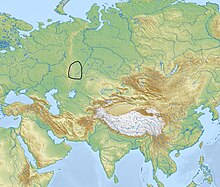
Back حضارة سينتاشتا Arabic Sintaşta mədəniyyəti Azerbaijani Һынташты мәҙәниәте Bashkir Синтащинска култура Bulgarian সিনতাশতা সংস্কৃতি Bengali/Bangla Kultura Sintašta Czech Синташта культури CV Sintaschta-Kultur German Cultura de Sintashta Spanish فرهنگ سینتاشتا Persian
 | |
| Period | Late Middle Bronze Age |
|---|---|
| Dates | 2200–1900 BCE |
| Type site | Sintashta |
| Major sites | Sintashta Arkaim Petrovka |
| Characteristics | Extensive copper and bronze metallurgy Fortified settlements Elaborate weapon burials Earliest known chariots |
| Preceded by | Corded Ware culture Poltavka culture Abashevo culture |
| Followed by | Andronovo culture, Srubnaya culture, Sauromatians |
| Part of a series on |
| Indo-European topics |
|---|
 |
The Sintashta culture[a] is a Middle Bronze Age archaeological culture of the Southern Urals,[1] dated to the period c. 2200–1900 BCE.[2][3] It is the first phase of the Sintashta–Petrovka complex,[4] c. 2200–1750 BCE. The culture is named after the Sintashta archaeological site, in Chelyabinsk Oblast, Russia, and spreads through Orenburg Oblast, Bashkortostan, and Northern Kazakhstan. The Sintashta culture is thought to represent an eastward migration of peoples from the Corded Ware culture.[5][6][7][8] It is widely regarded as the origin of the Indo-Iranian languages (Indo-Iranic languages[9][10]),[11][12][13] whose speakers originally referred to themselves as the Arya.[14][15] The earliest known chariots have been found in Sintashta burials, and the culture is considered a strong candidate for the origin of the technology, which spread throughout the Old World and played an important role in ancient warfare.[16][17][18][19] Sintashta settlements are also remarkable for the intensity of copper mining and bronze metallurgy carried out there, which is unusual for a steppe culture.[20] Among the main features of the Sintashta culture are high levels of militarism and extensive fortified settlements, of which 23 are known.[21]
Cite error: There are <ref group=lower-alpha> tags or {{efn}} templates on this page, but the references will not show without a {{reflist|group=lower-alpha}} template or {{notelist}} template (see the help page).
- ^ Lindner 2020, p. 362: "The publication of new radiocarbon data series from selected burial sites in the South-eastern Urals has helped to establish a much more accurate chronology for the late Middle Bronze Age Sintashta-Petrovka complex".
- ^ Epimakhov, Zazovskaya & Alaeva 2023, p. 6: "The earliest values in the series refer to the Sintashta culture (Sintashta II [the early phase], Kamenny Ambar-5 [Kurgan 2])—2200–2000 calBC".
- ^ Lindner 2020, p. 362: "[A] much more accurate chronology for the late Middle Bronze Age Sintashta-Petrovka complex".
- ^ Mathieson 2015, Supplementary material: "Sintashta and Andronovo populations had an affinity to more western populations from central and northern Europe like the Corded Ware and associated cultures. [...] the Srubnaya/Sintashta/Andronovo group resembled Late Neolithic/Bronze Age populations from mainland Europe.".
- ^ Chintalapati, Patterson & Moorjani 2022, p. 13: "[T]he CWC expanded to the east to form the archaeological complexes of Sintashta, Srubnaya, Andronovo, and the BA cultures of Kazakhstan.".
- ^ Rowlett, Ralph M. "Research Directions in Early Indo-European Archaeology." (1990): 415-418.
- ^ Heggarty, Paul. "Prehistory by Bayesian phylogenetics? The state of the art on Indo-European origins." Antiquity 88.340 (2014): 566-577.
- ^ Mallory & Mair 2008, p. 261.
- ^ Anthony 2007, pp. 408–411
- ^ Lubotsky 2023, p. 259, "There is growing consensus among both archaeologists and linguists that the Sintashta–Petrovka culture (2100–1900 BCE) in the Southern Trans-Urals was inhabited by the speakers of Proto-Indo-Iranian".
- ^ Schmitt 1987: "The name Aryan is the self designation of the peoples of Ancient India and Ancient Iran who spoke Aryan languages, in contrast to the 'non-Aryan' peoples of those 'Aryan' countries."
- ^ Anthony 2007, p. 408.
- ^ Chechushkov, I.V.; Epimakhov, A.V. (2018). "Eurasian Steppe Chariots and Social Complexity During the Bronze Age". Journal of World Prehistory. 31 (4): 435–483. doi:10.1007/s10963-018-9124-0. S2CID 254743380.
- ^ Raulwing, Peter (2000). Horses, Chariots and Indo-Europeans – Foundations and Methods of Chariotry Research from the Viewpoint of Comparative Indo-European Linguistics. Archaeolingua Alapítvány, Budapest. ISBN 9789638046260.
- ^ Anthony 2007, p. 402, "Eight radiocarbon dates have been obtained from five Sintashta culture graves containing the impressions of spoked wheels, including three at Sintashta (SM cemetery, gr. 5, 19, 28), one at Krivoe Ozero (k. 9, gr. 1), and one at Kammeny Ambar 5 (k. 2, gr. 8). Three of these (3760 ± 120 BP, 3740 ± 50 BP, and 3700 ± 60 BP), with probability distributions that fall predominantly before 2000 BCE, suggest that the earliest chariots probably appeared in the steppes before 2000 BCE (table 15.1 [p. 376]).".
- ^ Holm, Hans J. J. G. (2019): The Earliest Wheel Finds, their Archeology and Indo-European Terminology in Time and Space, and Early Migrations around the Caucasus. Series Minor 43. Budapest: ARCHAEOLINGUA ALAPÍTVÁNY. ISBN 978-615-5766-30-5
- ^ Hanks & Linduff 2009.
- ^ Semyan, Ivan, and Spyros Bakas, (2021). "Archaeological Experiment on Reconstruction of the 'Compound' Bow of the Sintashta Bronze Age Culture from the Stepnoe Cemetery", in EXARC Journal Issue 2021/2, Introduction.